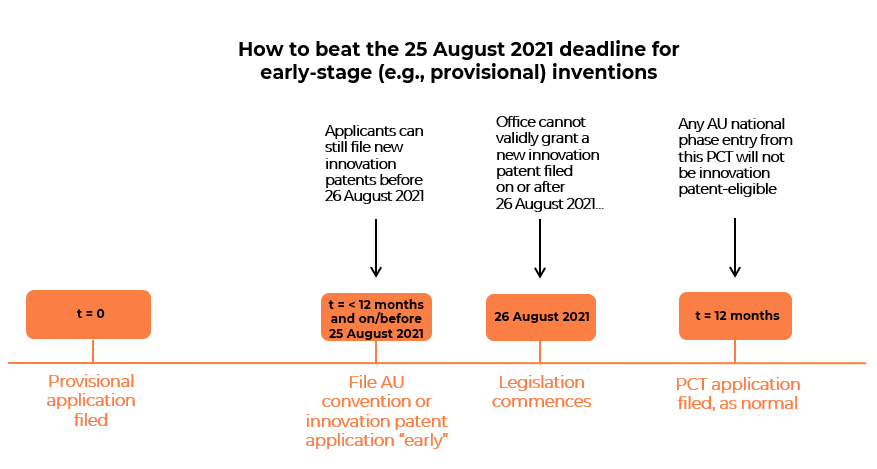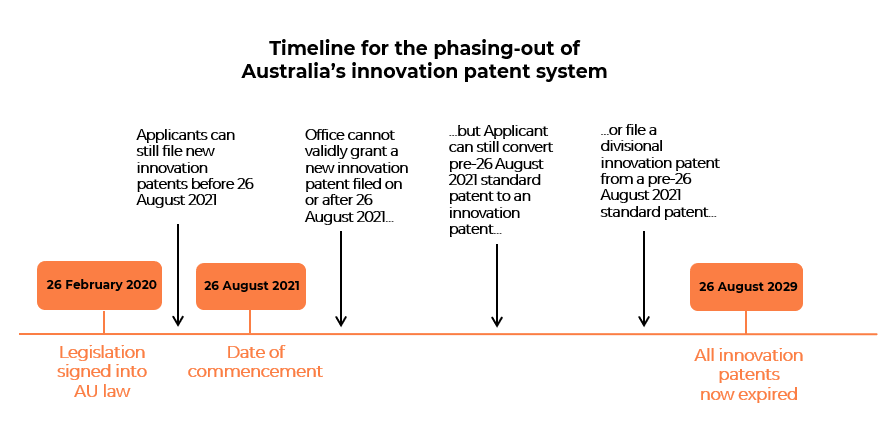The abolition of Australia’s second-tier “innovation patent” system has been well publicised and comes with a “magic date” of 25 August 2021. But what does “abolition” really mean, and what can’t you do come 26 August 2021 that you could do one day prior? In this article, we break it all down and let you know what you really need to know – so that there are no nasty surprises down the line.
What must I do on or before 25 August 2021?
This is perhaps the most critical (and misunderstood) aspect of the changes. In order for a new innovation patent to be filed validly, it must come with a filing date of 25 August 2021 or earlier. Now, for applications already filed in Australia (convention or national phase) or existing PCT international phase applications designating Australia, this is not a problem – your ability to make use of the innovation patent system is maintained (subject to certain caveats, see below).
However, for inventions currently covered by provisional applications (or even awaiting provisional filing), this is where things start to get interesting. You will need to file “early” (i.e., obtain a filing date of 25 August 2021 or sooner) in order for your invention to remain innovation patent-eligible. Practically speaking, foreign applicants may struggle to justify bringing their international phase filing forward simply to preserve their rights in Australia’s second-tier patent system. Rather, they may prefer to file early in Australia (as a standard patent application that can later be converted to an innovation patent, or as a direct-filed innovation patent application), leaving the PCT international phase to run its natural course.
We have attempted to capture this in the graphic below:

What can I still do come 26 August 2021 and after?
As noted above, for applications already filed in Australia (convention or national phase) or indeed existing PCT international phase applications designating Australia, this is not problem – your ability to make use of the innovation patent system is maintained. As shown on the timeline below, you can convert an existing standard patent application (i.e., having a filing date of 25 August 2021 or earlier) into an innovation patent, or can have a divisional innovation patent filed from it. That said, one further misconception stems from the fact that this divisional innovation patent can be filed at any time on or after 26 August 2021 (so long as the would-be 8-year term of the divisional innovation patent has not expired). Whilst this is technically correct, delaying filing does come with consequences in that your ability to claim damages (remembering that one of the principal uses of the innovation patent is as a “litigation weapon”) only dates back to the date of publication of the innovation patent, meaning this is very much a case of “the sooner the better”.

Commentary
The bottom line is that whereas the innovation patent system could have been “fixed” (which may have in turn given it a chance of achieving its stated goal of stimulating R&D amongst local SMEs), the Government had long-since decided its fate. It was always going to die and attempts to recover it, whilst deserving of a better outcome, ultimately amounted to little more than a fool’s errand. That we’ve landed where we have is a sad but inevitable consequence of a system that sounded good in theory, but was imperfect in design – and in this respect we need look no further than innovation patent 2001100012, which was “granted” (although later revoked) for a “circular transportation facilitation device” – a wheel. In many ways, the only surprise is that it’s taken us 20 years to get to where we are now.

